| Changes and New
Models In 1902 the Star Motor Company
changed its name to the Star Engineering Company. The
business expanded rapidly and diversified. Parts such as
wheels and carburettors were made for other
manufacturers, and complete cars were supplied to Brown
Brothers, the motor factors. The Stewart Street works
were expanded and additional premises were obtained in
neighbouring Ablow Street, and Dobb Street. In 1903 a
new factory was built in Frederick Street on a 40,000sq.ft. site.
It included an assembly shop,
offices, stores and a pattern shop. |
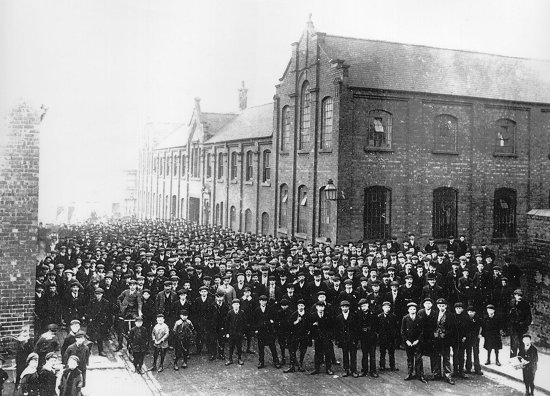 |
Star workers filling Frederick
Street outside the new Star factory.
They were dressed in their "Sunday
best" so the photograph must have been taken on a
special occasion.
Courtesy of the late David Evans. |
|
Star soon moved away from the
Star-Benz design and began to manufacture more advanced
designs of its own.
By 1903 several models were
available including 10, 15, and 20hp. four-cylinder
cars, and 7 and 10hp. two-cylinder cars.
The ‘Little Star’, introduced early
in 1904 became very popular. Built along the lines of a
Panhard, it had a 7hp. twin-cylinder engine, and sold
for £175.
By this time the range had been
extended to include a 12hp. four-cylinder car that sold
for £450.
|
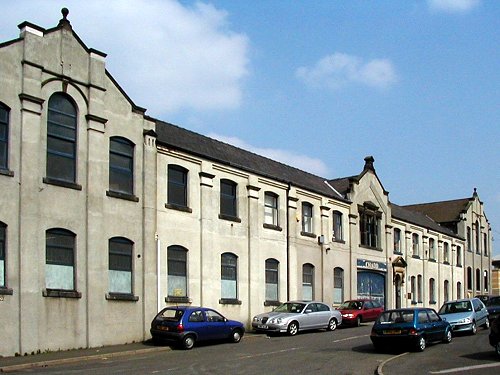
A more modern view of the works,
taken in 2001. |
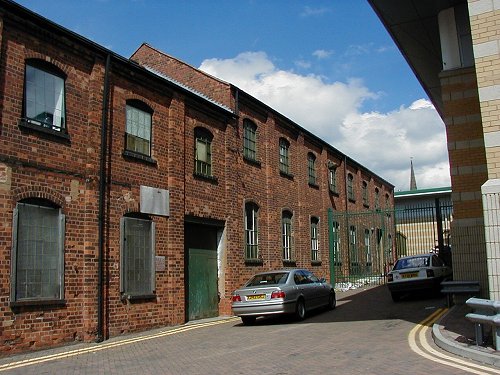 |
The eastern end of Frederick
Street works, looking up what remains of Nelson Street. |
| A final view of Frederick
Street works taken in 2001. |
 |
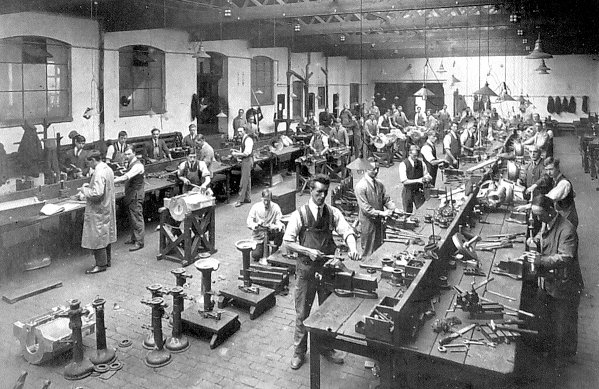 |
The engine shop.
Courtesy of Norman Tonry. |
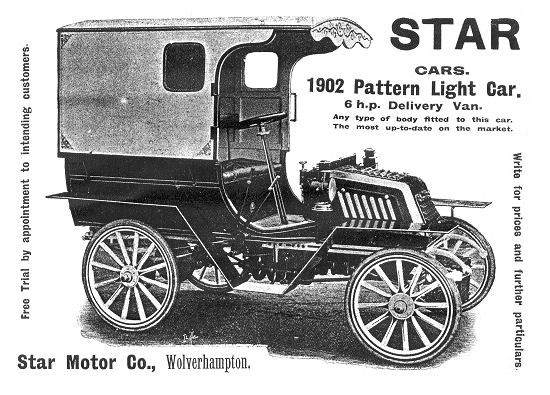
An advert from 1902.
|
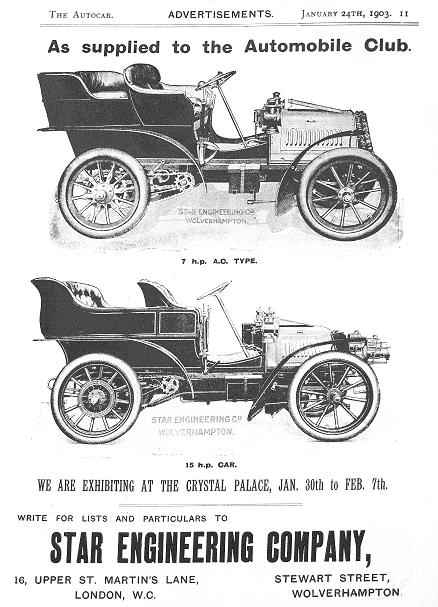
An advert from 1903. |
|
| |

Another advert from 1903. |
|

Clive Cooper's 1904 Little Star at
the Black Country Living Museum in 2001. |
In 1905 the company was affected by
a deep depression in the bicycle trade that resulted in
a noticeable decline in cycle sales.
At the 1905 A.G.M.
there was talk of price cutting and depot losses, and
the trade press reported that in order to hold its own,
Star had been forced to pursue foreign sales with
renewed vigour.
|
| In order to reduce losses the
decision was taken to introduce a cheaper car called the
‘Starling’ that would sell through cycle agents for
£110.
The car had a single-cylinder De Dion engine, and
a two-speed gearbox. After a year the name ‘Stuart’ was
adopted for these cars, and also used for Star cars
exported to New Zealand.
In 1907 the ‘Starling’ name was
re-adopted and production of them continued until 1909.
The ‘Stuart’ car had a 7hp. twin-cylinder engine, 3
forward speeds and reverse, and a Cardan shaft drive.
Three versions were available, a two-seater, a
three-seater, and a four-seater. The three-seater sold
for £180, and the four-seater sold for £190. The later
‘Starling’ models had a 6hp. single-cylinder engine, 3
forward speeds and reverse, a chain drive, and a ‘live’
back axle. |

Another view of Clive Cooper's
Little Star. |
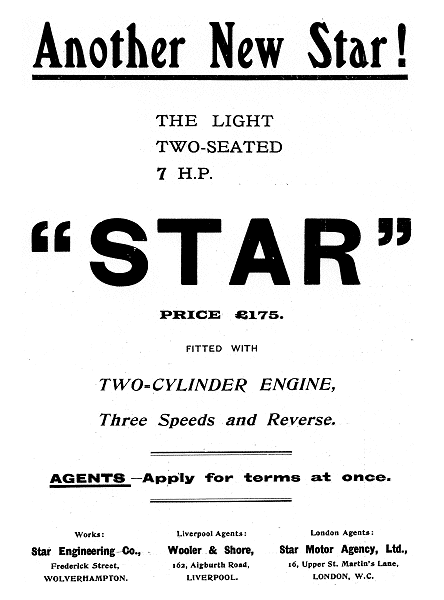
An advert from April 1904.
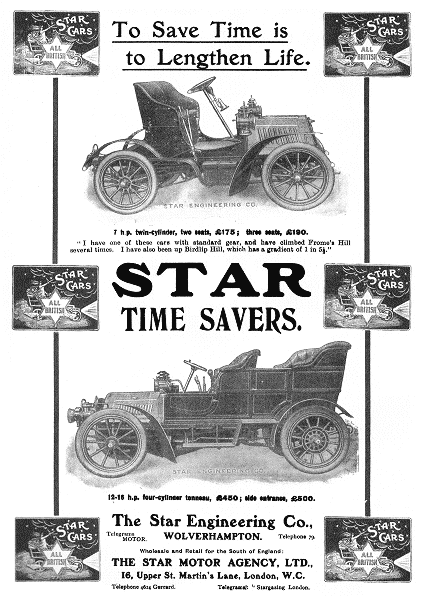 |
An advert from 'The Autocar'
magazine, December 31st, 1904. |
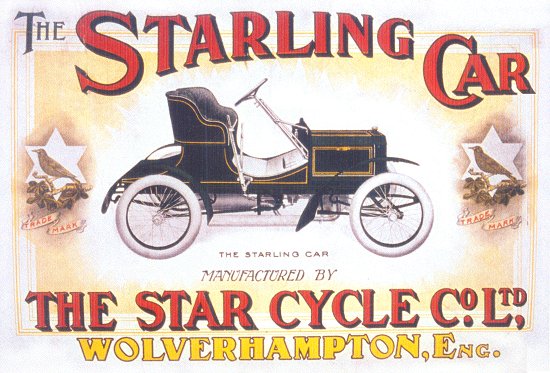
A 1905 advertising card for hanging in agents'
windows. Courtesy of David Evans.
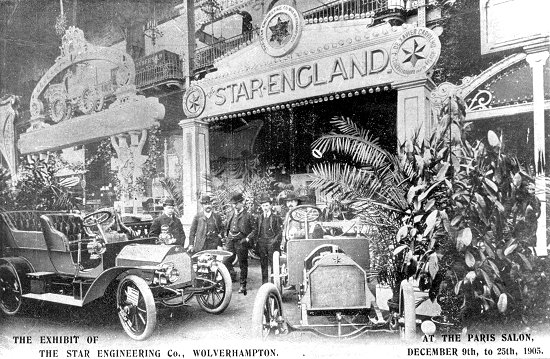
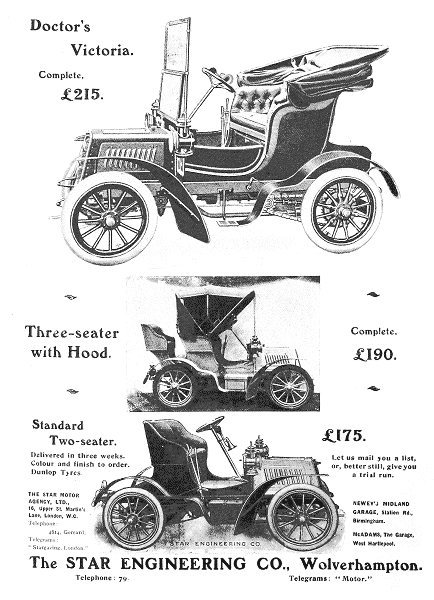
An advert from April 1905.
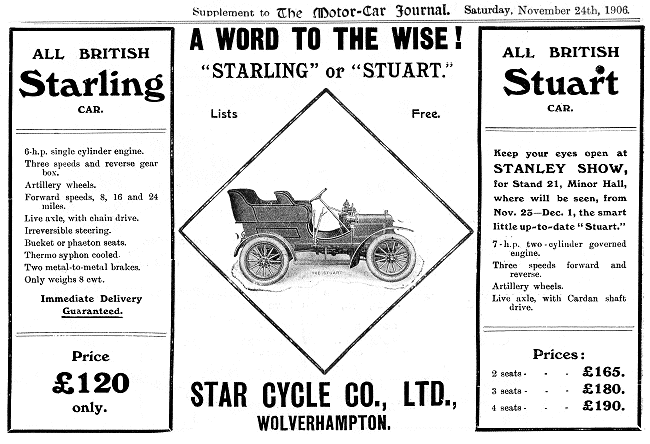
An advert from 1906. Courtesy of Ray Jones.
|
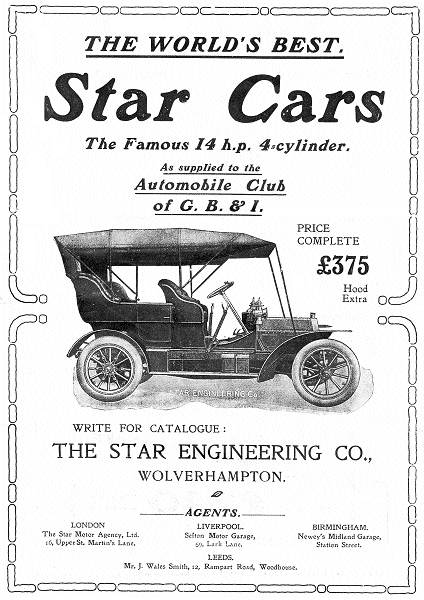
A 1906 advert from "The Motor".
Courtesy of Peter Lisle. |
In 1907 the first six-cylinder Star
appeared and sold for around £600. Two years later the
popular four-cylinder 15hp. model was launched. It sold
for around £300 and had a 2.8 litre engine, dual
ignition and a shaft drive. By 1912 it had become the 3
litre 15.9hp.
In January 1909 an Extraordinary
General Meeting was held at the Star and Garter Hotel
during which the decision was taken to change the Star
Engineering Company into a limited liability company.
The newly formed Star Engineering Company Limited now
took over the Star Cycle Company Limited and at the same
time formed a new subsidiary company; The Star Cycle
Company.
Joseph Lisle, one of Edward Lisle's
sons became Managing Director of the
Star Engineering Company Limited.
|
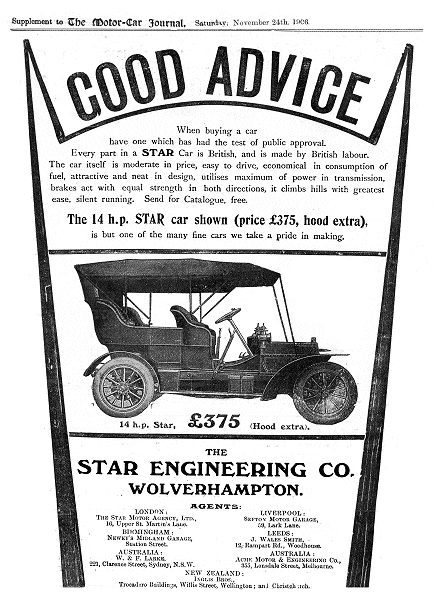
Another advert from 1906. Courtesy of Ray
Jones.
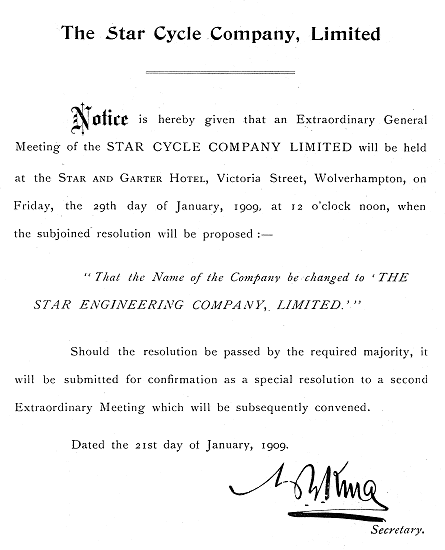
Courtesy of Peter Lisle.

Another advert from 1906. Courtesy of the late
Jim Boulton.
| 1909 saw the formation of the
Briton Motor Company under the control of Edward Lisle
Junior, one of the sons of Star's founder.
The production of
‘Starling’ cars ceased and Briton took over the Stewart
Street Works where the ‘Starling’ and ‘Stuart’ cars had
been built.
The same workforce was employed, and the
first model, the two-cylinder, 7 hp. (later increased to
10 hp.) ‘Little Briton’ soon appeared. It sold for 175
guineas.
Other models quickly followed. There were
four-cylinder 12hp., 14hp., and 16hp. cars.
In 1912
Briton acquired a new factory in Lower Walsall Street,
Wolverhampton and vacated the Stewart Street works. |
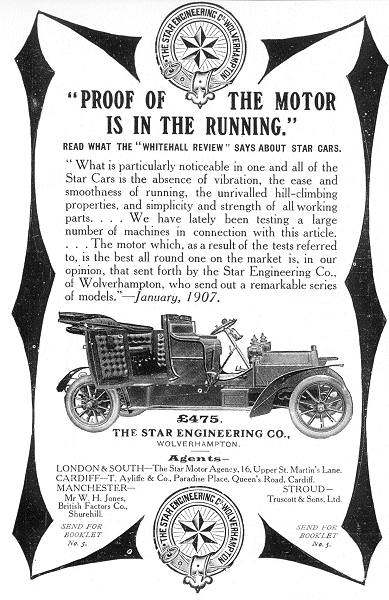
An advert from 1907. Courtesy of
Peter Lisle. |

An advert from 1908. Courtesy of the late Jim
Boulton.
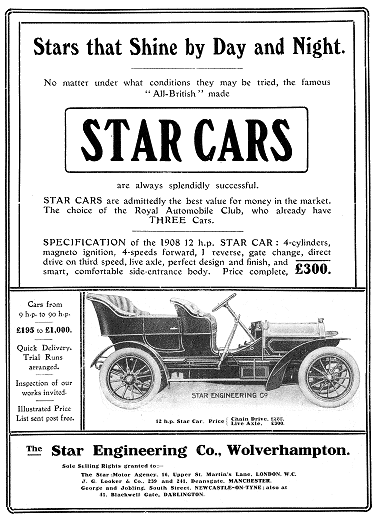 |
Another advert from 1908, as
seen in 'The Motor' 19th May, 1908. |
This lovely photo of a family and
their Star car, taken around 1908, was kindly sent by
Nick Shippobotham.
The lady on the left is his
great grandmother.
|
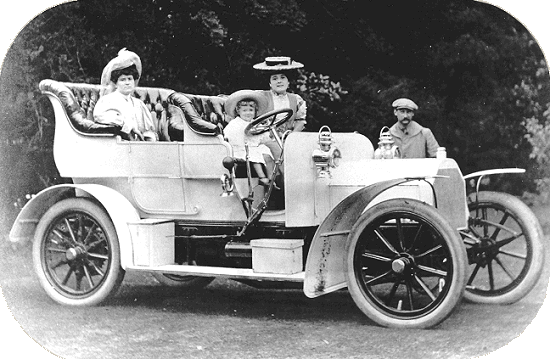 |
| The Star 'Weather Screen' was launched in May, 1908.
It consisted of a sheet of flexible waterproof canvas,
wound around a spring roller which was mounted above the
dashboard on a pair of jointed bars. The product was
described in 'The Motor' magazine as follows:. |
|
A New Weather Screen
Illustrations show a patent weather
screen which the Star Engineering Company,
Wolverhampton, have just placed on the
market. The screen is composed of a sheet of
flexible weatherproof canvas that is wound
round a spring roller, the axis of which is
carried by the dashboard, and the free edge
of this sheet is stiffened by a suitable bar
which is connected with the dashboard
through the medium of a pair of jointed
bars, each of which is formed in two lengths
pivotally connected together by means of a
joint of the knife-blade type which allows
the two lengths to be substantially closed
together in one direction, but prevents them
from being moved more than slightly out of
line with one another in the opposite
direction.
The portions of each bar are also
provided with joints either at their
connection with the main support, or with
the stiffening bar which limits their
turning movement, one of them in one
direction and the other in the other
direction, so that when the bars have been
opened out to hold the stiffening bar in its
upward position with the sheet drawn upwards
from the roller, the bars cannot move
sideways and allow the stiffening bar to
fall. When the bars have been opened (for
the purpose of holding up the stiffening bar
of the sheet against the pull of the spring
roller) they are stopped from further
movement in the same direction by the stop
joint between the two lengths of which they
are each composed, and two lengths of each
bar have moved sufficiently out of line with
one another to ensure that they cannot
accidentally turn backwards.
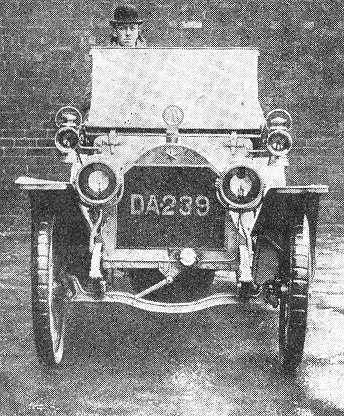 |
|
 |
|
The new
Star weather screen. |
|
|
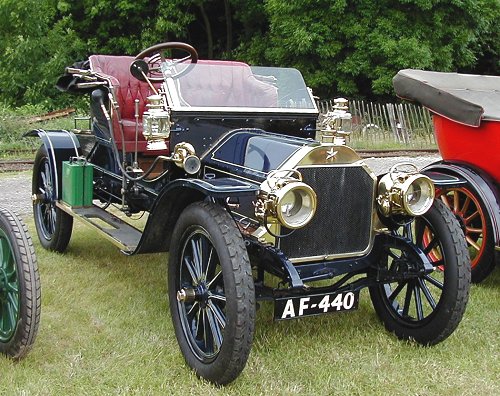 |
P. Whitty's 1909, 4-cylinder,
12hp. Star. As seen at
the Black Country Living Museum in 2001. |
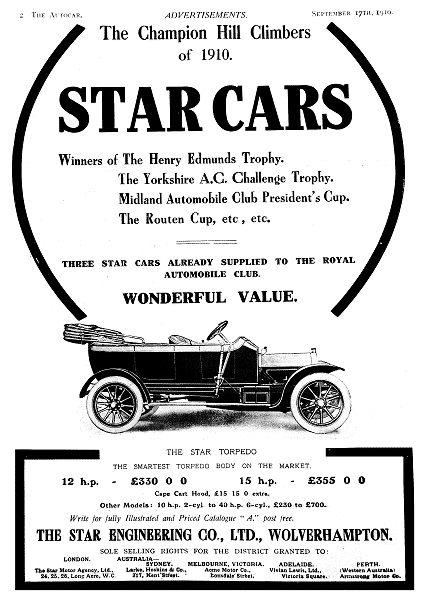
An advert from 1910.

C. Howe's 1910 15hp. 4-seater tourer. Courtesy
of Peter Lisle.
| In 1911 Star produced a 2-cylinder 10hp.
car and several 4-cylinder models, including 12hp.,
15hp., 20hp., and 25hp. cars. There were two 15hp.
cars, one being the up-market 15hp. De Luxe. |
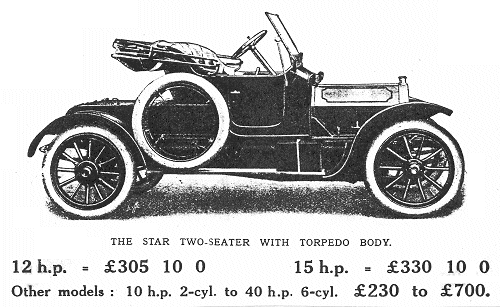
Another advert from 1910. |

|
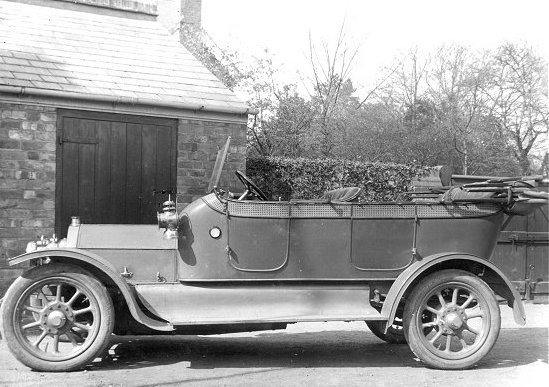
A 15hp. tourer from 1912. Courtesy
of the late Jim Boulton. |
Soon after Briton’s move to Lower
Walsall Street a disastrous fire gutted the body shops
in Dobbs Street.
Luckily production could continue much
as before, by moving the body building department into
the now empty factory in Stewart Street. |
| The
1912 Star Victoria tourer that's in the collection at
the Black Country Living Museum, Dudley.
In the driver's seat is Ray
Salisbury, sitting alongside Stan Davis. Ray's wife Ann
is sitting in the back. |
 |
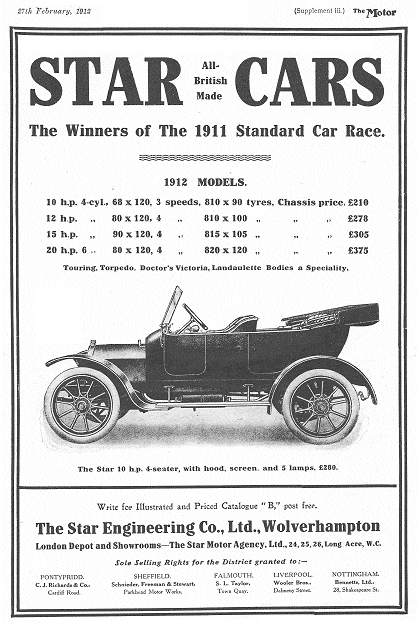
An advert from 1912.
 |
Another view of the
1912 Star Victoria tourer at the Black Country Living
Museum. With an extremely
young "driver". |
|

An article from 'The Engineer'. |
| Another article about Star appeared in the November
22nd, 1912 edition of 'The Engineer': |
|
 |
Motor Car Show at
Olympia
Another particularly well designed car of the
15.9 horsepower class is that shown by the 'Star
Engineering Company, Limited, Wolverhampton. An
elevation and plan of the chassis are given in
Figs. 20 and 21, while Figs. 22, 23, 24, and 25
show the construction of the engine, clutch
mechanism, gearbox, and back axle. The engine
has four cylinders cast in pairs, with a bore of
80 mm. and stroke of 150 mm. The valves are all
on one side and the cam and magneto shafts are
operated by separate chains from the crankshaft,
while the oil and water pumps are driven by a
third chain. from the rear end of the camshaft.
The chains are fairly heavy, and as the drives
are short, the makers claim that no means of
adjustment is necessary. The oil is drawn from a
sump in the crank chamber by means of a pump and
forced to the main bearings of the crankshaft
through passages drilled in the crank cheeks and
big ends. The main crankshaft bearings are
carried from the upper part of the crank chamber
so that the latter can be removed without
disturbing the crank shaft. The clutch is of the
leather-faced conical pattern enclosed in an
oil-tight casing. There is a double universal
joint between the crank and gear shafts, and the
gearbox is suspended at three points from two
cross members of the chassis. All the gear
shafts are short and run in ball bearings with
the exception of the spigot of the primary
shaft, which runs in plain bearings.
Four road speeds and a reverse are provided, and
the final drive is by means of a propeller shaft
and bevel gearing. Ball bearings are fitted
throughout in the back axle. The rear springs
are of the three quarter elliptical type, and
also serve the purpose of radius and torque rods
as in the Sunbeam car.
|
 |
|
|
| |
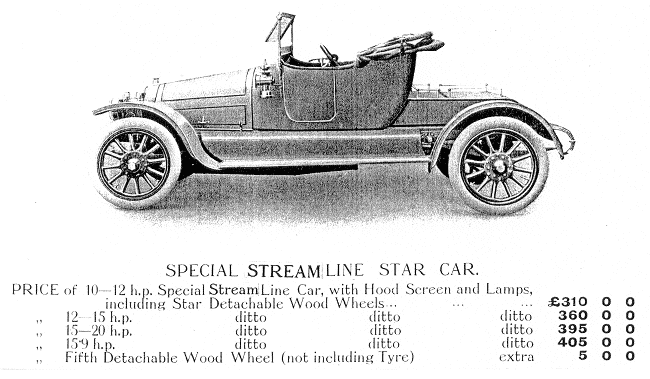
From the 1913 Star catalogue. |
|
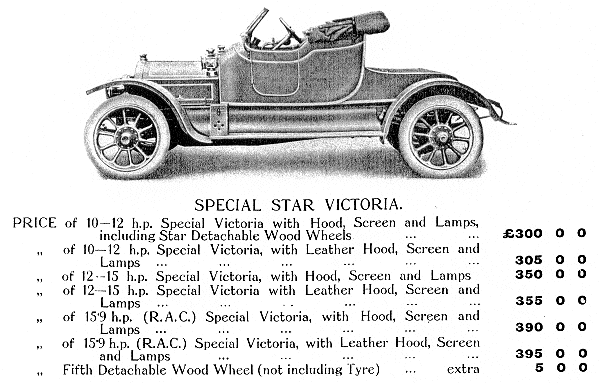
From the 1913 Star catalogue. |
|
| An advert from 'The Motor'
magazine, 10th April, 1912. |
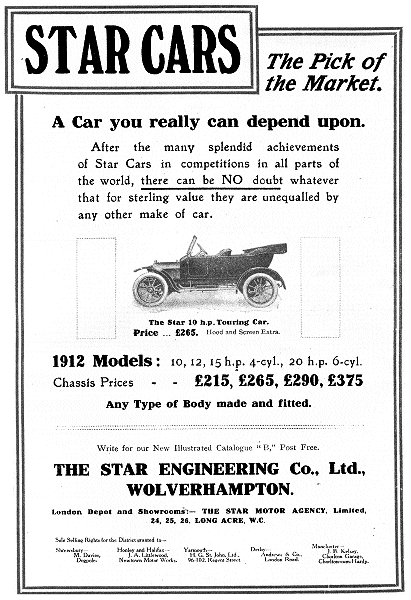 |

 |
Christopher Habgood's 1914
Star Torpedo tourer. As
seen at the Black Country Living Museum in 2001. |
| Another view of Christopher Habgood's 1914
Star Torpedo tourer. This
time at the 2008 Festival of Black Country Vehicles, at
the
Black Country Living Museum. |
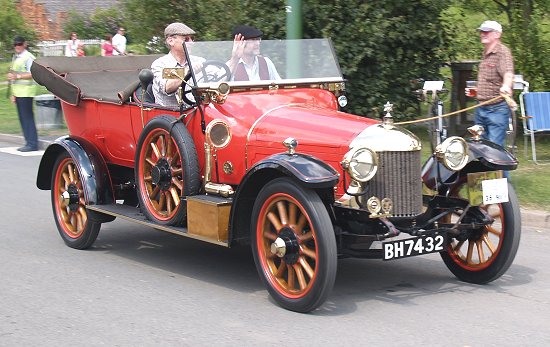 |
|
Star’s range of models increased with the
introduction of the 10/12, the 11.9hp. and the 20.1hp.
cars. The 15.9hp. and the 20.1hp. models were also
available with bull-nosed radiators and streamlined
bodies. Production increased to twenty vehicles a week,
and the cars became well known for their reliability. By
1914 Star had become the sixth largest vehicle
manufacturer in the country. |
|
 |
|
 |
|
 |
|
Return to
The Star-Benz |
|
Return to the
Contents |
|
Proceed to The
First World War |
|
|